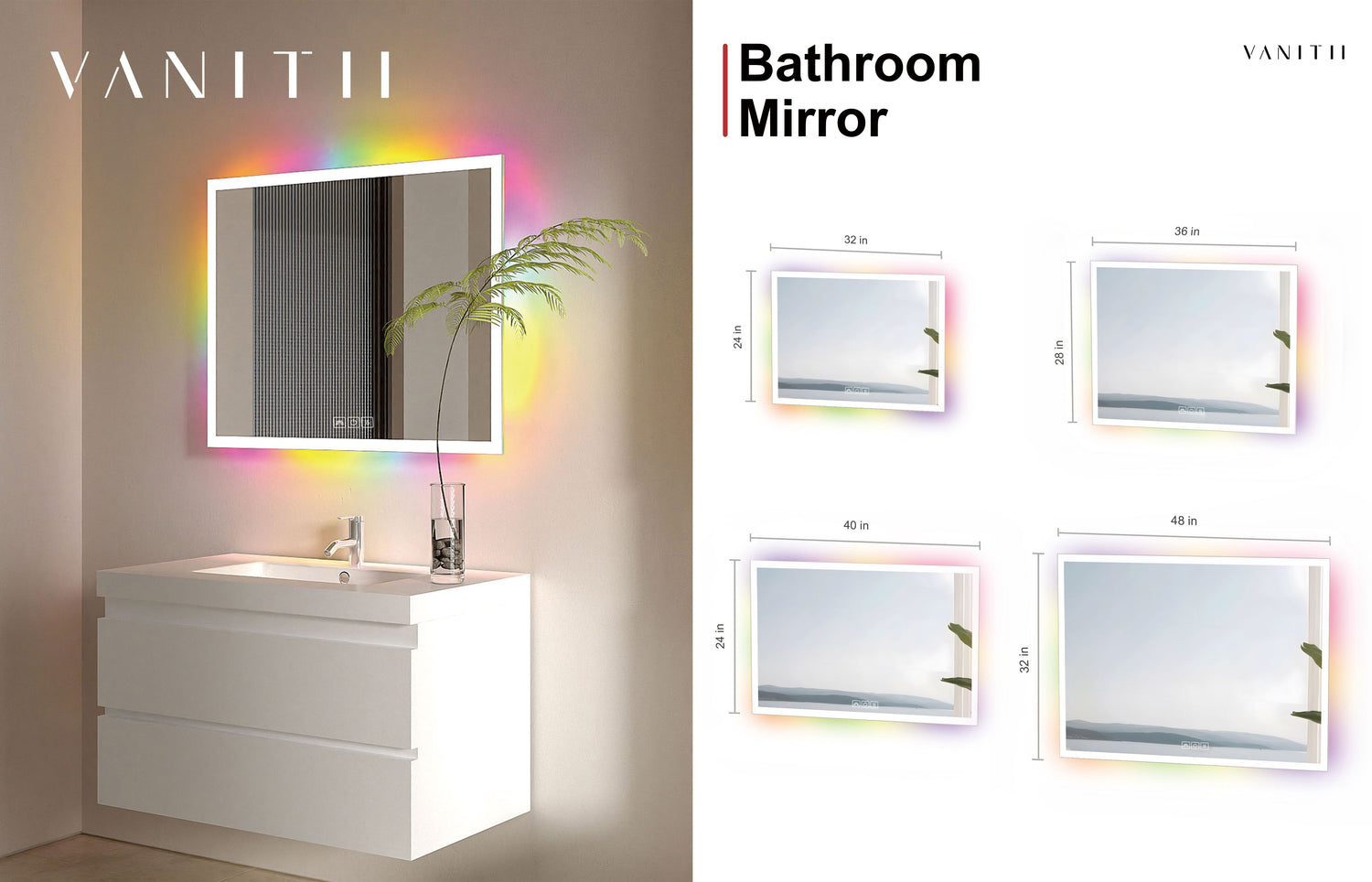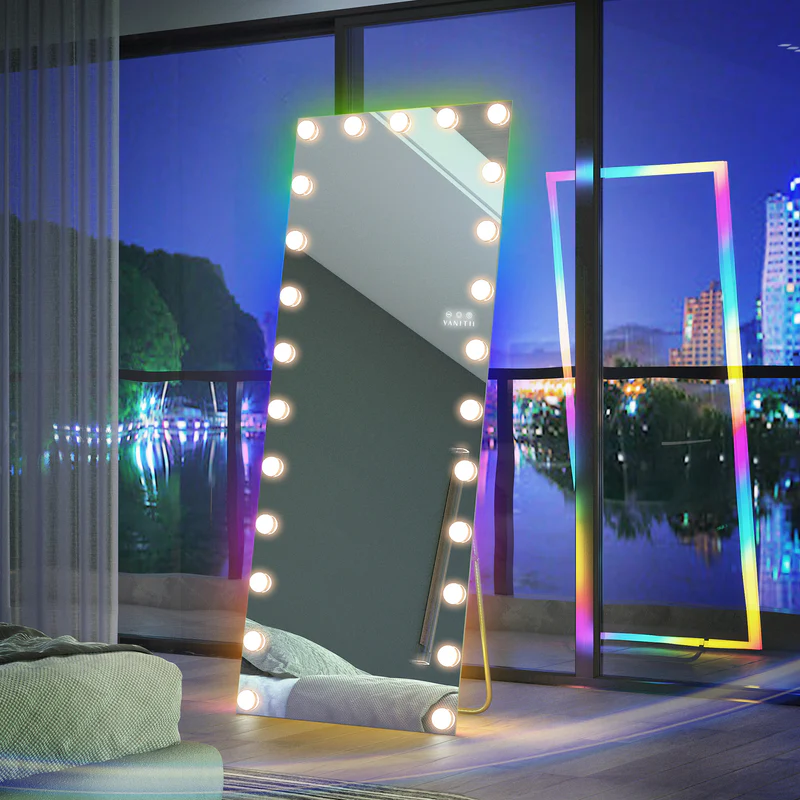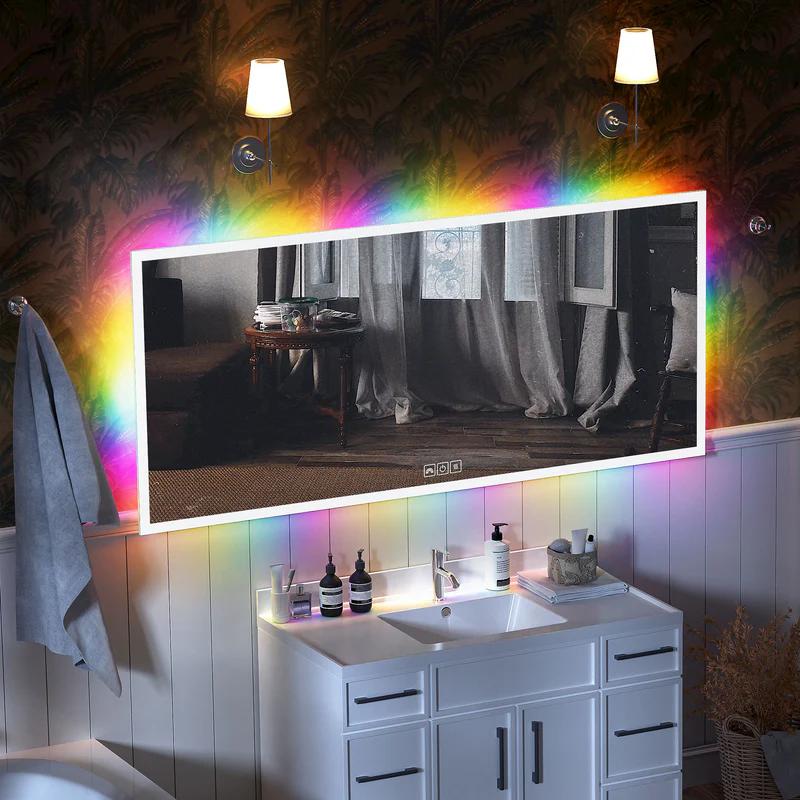Your daily ritual as well as the look of your house depend on the bathroom mirror you choose. A excellent mirror accentuates your space, brightens regular grooming chores, and could enlarge the appearance of a small bathroom. From the mirror type to the size of your bathroom and lighting, various elements will influence your decision whether you wish to replace an old mirror or require a new one for a makeover. This article addresses your choices to enable you to choose a mirror within your budget and requirements.
Five Basic Bathroom Mirror Types
Bathroom mirrors come in various styles and designs, each serving different needs and preferences. The right type of mirror can enhance both your daily routine and your bathroom's overall look.
1. Standard Flat Mirrors
Bathrooms still depend mostly on plain flat mirrors. These mirrors produce crisp, accurate reflections either with or without frames. Bathrooms would find most flat mirrors perfect as their protective backing stops moisture damage. Often the most reasonably priced solution, their basic shape fits any decorating style.

2. LED and Backlit Mirrors
LED mirrors provide your bathroom elegance as well as utility. Even illumination from built-in lights around the mirror's edges helps with jobs like shaving or applying makeup. On these mirrors, the lighting choices are really flexible; you may change the brightness level and alternate between warm and cool illumination. Touch-sensitive controls for simple operation abound on many models. Using less energy than conventional bathroom lighting, these mirrors also are energy-efficient.
3. Smart Mirrors
Smart bathroom mirrors mix contemporary technologies with classic mirror purposes. Beyond simple introspection, the temperature. Bluetooth speakers on several versions let you enjoy music while getting ready. Easy setting adjustment is made possible by voice control. Although these mirrors cost more, their extra functions will help your morning ritual run more quickly.
4. Magnifying Mirrors
Perfect for careful work are magnifying mirrors. Usually ranging from three to 10 times normal reflection, these specialist mirrors provide different magnificence degrees. Usually, designs feature movable arms that let you precisely where you need the mirror. There are wall-mounted and countertop types as well as some that have a conventional mirror on one side with magnification on the other. These mirrors complement your primary bathroom mirror really nicely as supplements.
5. Venetian Mirrors
Venetian mirrors add elegance to bathroom decor through their distinctive style. The glass features intricate etched designs and detailed edge work that reflects traditional craftsmanship. Their frames often showcase ornate patterns that catch and reflect light throughout the room. While more decorative than functional, these mirrors can transform a basic bathroom into an elegant space. The scattered light reflection from their detailed surfaces helps brighten the room naturally.

Factors to Consider When Choosing a Bathroom Mirror
The right mirror for your bathroom depends on several practical factors. Here's what you need to think about before making your choice.
Bathroom Size and Layout
The mirror should fit your bathroom's space properly. Large mirror works well in small bathrooms by making them look bigger. Wide mirror can make narrow bathrooms appear broader. Check the space above your sink and vanity to make sure your chosen mirror will fit, and leave enough room around it for cleaning.
Natural Lighting Conditions
Your bathroom's natural light affects your mirror choice. If you have big windows, avoid placing mirrors where they might create glare. For bathrooms with little natural light, you might want a mirror with built-in lights. Placing mirrors near windows helps spread light around the room.
Moisture Resistance
Bathrooms get steamy and wet, so your mirror needs proper protection. Look for mirrors with good sealing and water-resistant backing. Choose frames that won't rust or warp from moisture. Anti-fog features are helpful if your mirror often gets steamy from showers.
Installation Requirements
Each mirror type needs specific installation methods. Heavier mirrors need strong wall supports. Mirrors with lights need to be near electrical outlets. Consider whether you'll need professional help for installation. Also check if your bathroom walls can support your chosen mirror type.
Budget Planning
Mirror prices range from basic to expensive. Simple flat mirrors cost less but might need separate lighting. LED and smart mirrors cost more but include useful features. Remember to include any extra costs like installation or special mounting hardware in your budget.

Essential Features for a Quality Bathroom Mirror
A good bathroom mirror should have several key features to ensure durability and function. These features affect how well the mirror performs and how long it lasts.
Fog Resistance
Anti-fog coating prevents steam from blocking your view after hot showers. This coating helps the mirror stay clear, making it easier to use right after bathing. Some mirrors come with built-in heating elements that work the same way as your car's rear window defogger.
Mirror Thickness
A mirror should be at least 4mm thick for bathroom use. Thicker mirrors resist warping and breaking better than thin ones. They also give clearer reflections and feel more solid when mounted. The extra thickness helps prevent distortion that can happen with thinner mirrors.
Quality Backing
The mirror's backing protects it from moisture damage. Good backing prevents the silvering (the reflective part) from peeling or spotting. Look for mirrors with copper-free or sealed backing designed for bathroom conditions. This protection helps your mirror last longer without developing dark spots or edges.
Edge Treatment
Beveled or polished edges make mirrors safer and more attractive. Beveled edges catch light nicely and add style to plain mirrors. Polished edges reduce sharp corners and protect against chips. These finished edges also help keep water from seeping behind the mirror.
Mounting Hardware
Strong mounting hardware keeps your mirror secure. The hardware should match your wall type and the mirror's weight. Look for corrosion-resistant brackets or hangers. Make sure the mounting system allows a small gap between the wall and mirror for air flow.

Best Mirror Options for Different Bathroom Types
Each type of bathroom has different needs and uses. The right mirror choice depends on the room's size and how people use it.
Small Bathrooms
Space-saving mirrors work best in small bathrooms. Frameless mirrors fit close to the wall and look lighter than framed ones. LED mirrors provide good lighting without taking up extra space. Consider a mirror that reaches to the ceiling - this can make your small bathroom look taller and bigger.
Master Bathrooms
Master bathrooms need mirrors that serve two people comfortably. Large frameless mirrors over double sinks give each person enough viewing space. Smart mirrors add useful features like built-in lighting and fog resistance. These mirrors should be wide enough for both users to see themselves clearly at the same time.
Powder Rooms
Powder rooms are perfect for more decorative mirrors. Since these rooms get less moisture and wear, you can use mirrors with beautiful frames. Venetian or framed mirrors add style to these small spaces. Choose a mirror size that fits the room's scale - too large a mirror can overwhelm a tiny powder room.
Shared Bathrooms
Shared bathrooms need tough, practical mirrors. Frameless mirrors with anti-fog coatings work well because they're easy to clean and stay clear even with frequent shower use. The mirror should be large enough to serve multiple users but not so fancy that it's hard to maintain. Durability matters more than decoration in these busy bathrooms.
Important Installation Tips for Bathroom Mirrors
Before mounting your bathroom mirror, several key installation factors need attention. Proper installation helps your mirror stay secure and work well for years.
Wall Support
Your walls must be strong enough to hold the mirror safely. Check for wall studs or use proper anchors for your wall type. Heavy mirrors need extra support - don't rely on just adhesive. If your bathroom has tile walls, you'll need special drill bits and mounting methods to avoid cracking the tiles.
Ventilation Space
Leave a small gap between the mirror and wall to prevent moisture buildup. This space lets air flow behind the mirror and helps prevent water damage. A proper gap also reduces the chance of mold growing behind the mirror. About 1/8 inch of space is usually enough.
Electrical Needs
LED and smart mirrors need proper power connections. Place these mirrors near existing outlets or plan to add new ones. Some mirrors need hardwired installation by an electrician. Check if your bathroom circuit can handle the extra power load from the mirror's features.
Height and Position
Mount your mirror at a height that works for everyone who uses it. The mirror's center should be at about eye level for average-height users. For double sinks, make sure the mirror covers both areas well. Keep the bottom edge a few inches above the faucet to protect it from water splashes.
Safety Checks
Secure mounting prevents accidents. Use all the mounting brackets or hardware that came with the mirror. Check the wall and mounting hardware regularly for signs of loosening. If your mirror is very large or heavy, consider professional installation to ensure safety.
Daily Care and Maintenance for Your Bathroom Mirror
Proper maintenance keeps your bathroom mirror clean and functional. Here's how to care for different parts of your mirror.
Regular Cleaning
Clean your mirror with the right products to avoid damage. Use a soft, lint-free cloth and glass cleaner that's safe for mirrors. Avoid ammonia-based cleaners on mirrors with special coatings. Wipe up water splashes quickly to prevent spots and streaks.
Protecting the Surface
Keep your mirror's special features working well. Don't scrub anti-fog coatings too hard. Clean fingerprints and toothpaste spots promptly to prevent staining. For mirrors with special coatings, use only recommended cleaning products to protect these surfaces.
Frame Care
Different frame materials need specific care. Clean wooden frames with appropriate wood cleaners and keep them sealed against moisture. Wipe metal frames with a dry cloth to prevent rust. Watch for any peeling finishes or loose decorative elements that need repair.
Electrical Component Care
LED and smart mirrors need extra attention. Keep the light fixtures clean for best brightness. Remove dust from sensors and controls regularly. If you notice dim lights or control problems, check the manufacturer's guide for maintenance tips.
Preventing Problems
Watch for early signs of mirror damage. Look for black spots or silvering at the edges that might show moisture damage. Clean the bathroom fan vents to keep moisture levels down. Address any problems quickly to extend your mirror's life.
Get the Right Mirror for Your Bathroom!
Your bathroom mirror should be robust and useful. When selecting one, consider your location, illumination, and intended purpose. Search for important characteristics including correct thickness and fog resistance. Choose a mirror within your means that doesn't sacrifice quality. The correct mirror will help you greatly and improve your bathroom for years to come with appropriate installation and basic care.




Leave a comment
This site is protected by hCaptcha and the hCaptcha Privacy Policy and Terms of Service apply.